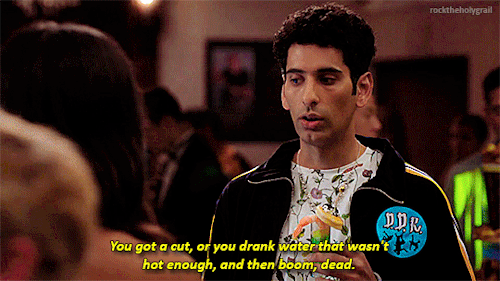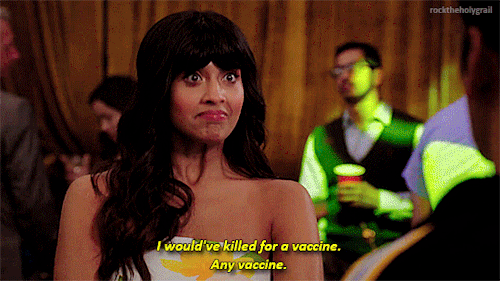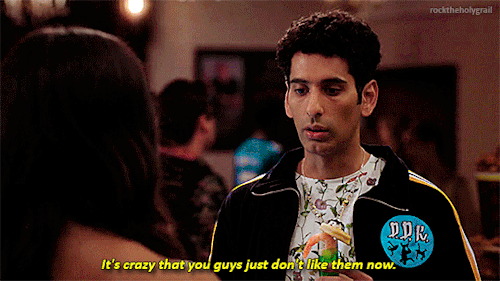The Good Place (2016-2020)






The Good Place (2016-2020)
More Posts from We-are-all-paranoid and Others

Mitochondria are primarily known as the powerhouse of the cell. However, these cellular organelles are required not only for providing energy: Professor Konstanze Winklhofer and her group at the Faculty of Medicine at Ruhr University Bochum, Germany, recently discovered that mitochondria play an important role in signal transduction in innate immune pathways.
They regulate a signaling pathway that helps to eliminate pathogens, but can cause damage through inflammation upon overactivation. The research team published their findings in the EMBO Journal.
Continue Reading.

fruitie punches
your bulldog isn’t being quirky it’s actively trying not to die every 10 seconds
biology is like the self discovery journey of a bunch of cells


candida and lactobacillus image under microscope / routine laboratory diaries
The public paid for "Moderna's" vaccine, and now we're going to pay again (and again and again)

Moderna is quadrupling the cost of covid vaccines, from $26/dose to $110–130. Moderna CEO Stephane Bancel calls the price hike “consistent with the value” of the mRNA vaccines. Moderna’s manufacturing costs are $2.85/dose, for a 4,460% markup on every dose:
https://arstechnica.com/science/2023/01/moderna-may-match-pfizers-400-price-hike-on-covid-vaccines-report-says/
If you’d like an essay-formatted version of this thread to read or share, here’s a link to it on pluralistic.net, my surveillance-free, ad-free, tracker-free blog:
https://pluralistic.net/2023/01/24/nationalize-moderna/#herd-immunity
Keep reading
Remember, folks, never pay to access a scientific article. Use a site like Sci-Hub, or failing that, e-mail the authors and request the data you need. Elsevier and their ilk are hoarders and thieves of knowledge, and they don’t deserve one cent more. Poach and pirate away; it is entirely justified.

The bacteria wars are coming. Researchers at Tel Aviv University have pitted “good” bacteria against “bad” bacteria and the good guys, it appears, are winning.
If the system can be scaled, this new approach could potentially replace antibiotics, which are increasingly struggling against antibiotic-resistant “superbugs.” For the TAU study, the researchers used a toxin injection system known as a “Type 6 Secretion System.” It’s usually deployed by pathogenic (“bad”) bacteria. They introduced the system into a “friendly” bacterium, Vibrio natriegens, which is not harmful to humans. The researchers described their technology as similar to a microscopic poison arrow shot from a good bacterium to eliminate a bad bacterium under specific conditions. “The system that we built allows us to engineer ‘good’ bacteria that can recognize pathogenic bacteria, attack them with toxins, and neutralize them,” explains Dr. Dor Salomon, who co-led the study. “We know how to change and control every component in the system and create a bacterium that neutralizes different strains of bacteria. This is proof of feasibility, showing that we have the knowledge and ability to create bacteria that take advantage of this killing system and may serve as antibiotic treatments. ”The current bacteria prototype is best suited for bugs that occur naturally in saltwater. This is a growing concern, as fish and seafood constitute a major food source in many regions of the world. “Their productivity is severely impaired as a result of bacteria-borne diseases,” Solomon notes, “and since we want to avoid pouring antibiotics into aquaculture farms, a biological solution such as the one we have developed is an effective alternative.” The system will eventually be adapted to treat pathogenic bacteria in humans, farm animals and plants. Tel Aviv University has filed a patent application through Ramot, the university’s technology-transfer company. In addition to Solomon, Dr. Biswanath Jana and Kinga Kappel of the department of clinical microbiology and immunology at TAU’s Sackler Faculty of Medicine participated in the research. The results were published this month in the scientific journal EMBO Reports.

-
 sassiesillie liked this · 1 week ago
sassiesillie liked this · 1 week ago -
 homoromanticswordfights liked this · 1 week ago
homoromanticswordfights liked this · 1 week ago -
 vampire-boy-at-the-pool-mansion liked this · 2 weeks ago
vampire-boy-at-the-pool-mansion liked this · 2 weeks ago -
 son-of-the-antlered-ones liked this · 2 weeks ago
son-of-the-antlered-ones liked this · 2 weeks ago -
 tall-bowtoid reblogged this · 1 month ago
tall-bowtoid reblogged this · 1 month ago -
 martinezcookie liked this · 1 month ago
martinezcookie liked this · 1 month ago -
 its-broken-inside liked this · 1 month ago
its-broken-inside liked this · 1 month ago -
 tall-bowtoid liked this · 1 month ago
tall-bowtoid liked this · 1 month ago -
 therineye reblogged this · 1 month ago
therineye reblogged this · 1 month ago -
 therineye liked this · 1 month ago
therineye liked this · 1 month ago -
 twoheartsoneclara reblogged this · 1 month ago
twoheartsoneclara reblogged this · 1 month ago -
 faerieg liked this · 1 month ago
faerieg liked this · 1 month ago -
 inkpaperandbone reblogged this · 1 month ago
inkpaperandbone reblogged this · 1 month ago -
 bisexual-borderline-disaster reblogged this · 1 month ago
bisexual-borderline-disaster reblogged this · 1 month ago -
 feathersandfoxtails liked this · 2 months ago
feathersandfoxtails liked this · 2 months ago -
 cluelessnitwhit liked this · 2 months ago
cluelessnitwhit liked this · 2 months ago -
 nissaimmortal reblogged this · 2 months ago
nissaimmortal reblogged this · 2 months ago -
 nissaimmortal liked this · 2 months ago
nissaimmortal liked this · 2 months ago -
 lindamarieanson reblogged this · 2 months ago
lindamarieanson reblogged this · 2 months ago -
 wasntthatafunnyday reblogged this · 2 months ago
wasntthatafunnyday reblogged this · 2 months ago -
 wasntthatafunnyday liked this · 2 months ago
wasntthatafunnyday liked this · 2 months ago -
 the-murderlesscrow liked this · 2 months ago
the-murderlesscrow liked this · 2 months ago -
 tiriansjewel liked this · 2 months ago
tiriansjewel liked this · 2 months ago -
 invisibleraven reblogged this · 2 months ago
invisibleraven reblogged this · 2 months ago -
 taitumdiarcheldan liked this · 2 months ago
taitumdiarcheldan liked this · 2 months ago -
 my-my-my reblogged this · 2 months ago
my-my-my reblogged this · 2 months ago -
 manicpixieshitpost liked this · 2 months ago
manicpixieshitpost liked this · 2 months ago -
 onthehighwaytomel liked this · 2 months ago
onthehighwaytomel liked this · 2 months ago -
 chaoticpossibilities reblogged this · 2 months ago
chaoticpossibilities reblogged this · 2 months ago -
 mspaintly liked this · 2 months ago
mspaintly liked this · 2 months ago -
 under-the-starz liked this · 3 months ago
under-the-starz liked this · 3 months ago -
 robertjsoria liked this · 3 months ago
robertjsoria liked this · 3 months ago -
 give-up-dont liked this · 3 months ago
give-up-dont liked this · 3 months ago -
 notmysecret reblogged this · 3 months ago
notmysecret reblogged this · 3 months ago -
 moon-light-glitter reblogged this · 3 months ago
moon-light-glitter reblogged this · 3 months ago -
 its-his-dimples liked this · 3 months ago
its-his-dimples liked this · 3 months ago -
 brianasch1-blog liked this · 3 months ago
brianasch1-blog liked this · 3 months ago -
 loverofhsandallthings1d liked this · 3 months ago
loverofhsandallthings1d liked this · 3 months ago -
 didhewinkback liked this · 3 months ago
didhewinkback liked this · 3 months ago -
 narryffdreaming reblogged this · 3 months ago
narryffdreaming reblogged this · 3 months ago -
 space-puppeteer liked this · 3 months ago
space-puppeteer liked this · 3 months ago -
 zkfae reblogged this · 3 months ago
zkfae reblogged this · 3 months ago -
 thnksfrthewinchesters reblogged this · 3 months ago
thnksfrthewinchesters reblogged this · 3 months ago -
 wcwit reblogged this · 3 months ago
wcwit reblogged this · 3 months ago -
 zkfae liked this · 3 months ago
zkfae liked this · 3 months ago -
 mlepnosstan liked this · 4 months ago
mlepnosstan liked this · 4 months ago -
 outlook-hater reblogged this · 4 months ago
outlook-hater reblogged this · 4 months ago -
 fractured-inheritance reblogged this · 4 months ago
fractured-inheritance reblogged this · 4 months ago -
 alchemicalgemturtle liked this · 5 months ago
alchemicalgemturtle liked this · 5 months ago
